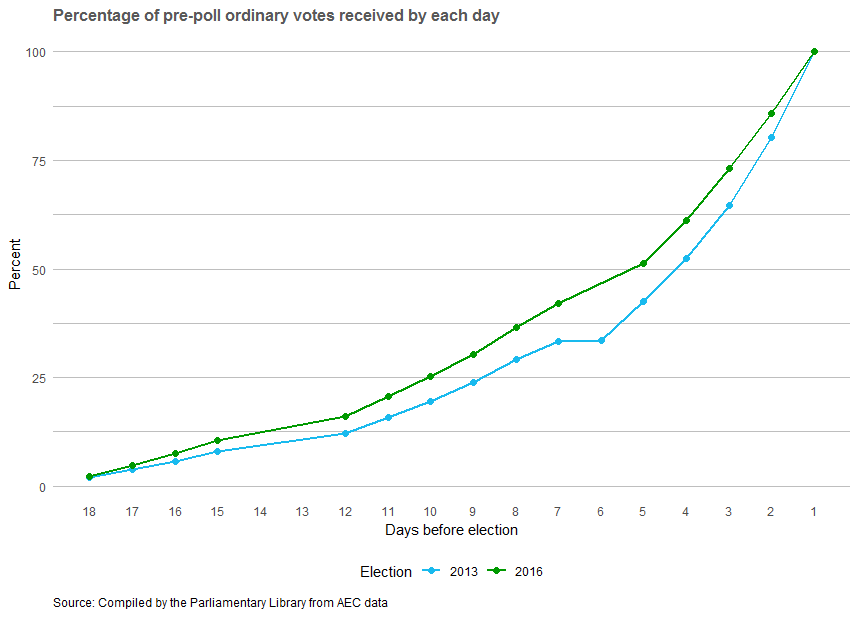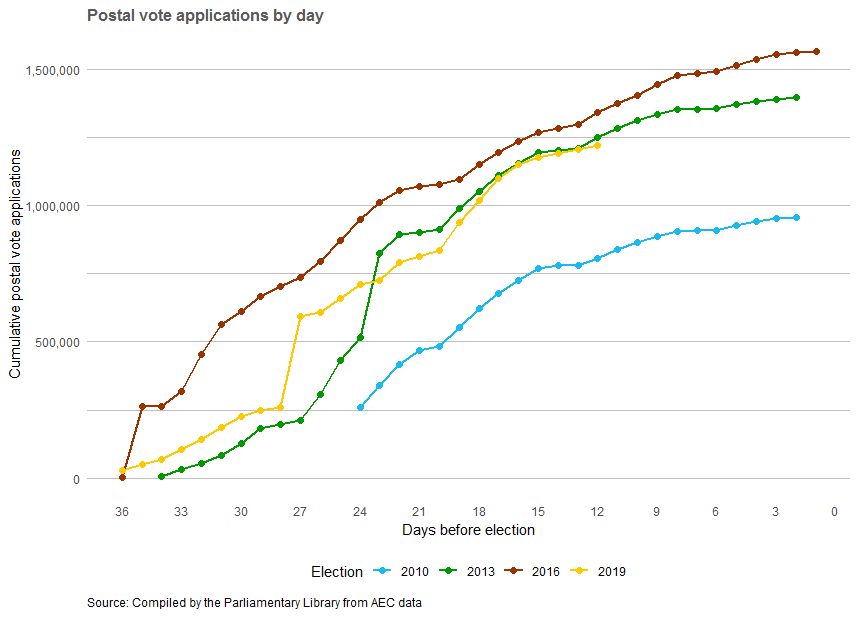Early voting for the 2019 federal election commenced on Monday 29 April 2019. Early votes include pre-poll ordinary votes (pre-poll votes cast by a voter at a pre-poll voting centre for their electorate), pre-poll declaration votes (pre-poll votes cast outside a voter’s division, such as overseas and interstate) and postal votes (which can be applied for from the issue of the writs). The rise of pre-poll voting, particularly pre-poll ordinary, has been a notable trend in federal elections since 2010.
By the 2016 federal election, 31.2 per cent of the formal votes cast in the election were early votes (compared to 26.4 per cent in 2013 and 17.4 per cent in 2010), constituting almost 4.5 million votes. About 2.7 million of these votes were pre-poll ordinary votes, and about 1.2 million were postal votes. However most of the increase since 2010 is largely due to pre-poll ordinary votes, with postal voting and pre-poll declaration votes remaining comparatively flat over that time.

In its report on the 2016 federal election, the Joint Standing Committee on Electoral Matters (JSCEM) recommended that pre-poll voting be restricted to no more than two weeks prior to the election. The Commonwealth Electoral Act 1918 currently allows pre-poll voting to commence five days after the declaration of nominations, which for the 2019 federal election has resulted in a three week pre-poll voting period similar to the early voting period in 2013 and 2016.
Statistics published by the Australian Electoral Commission (AEC) show how early voting proceeds over the election period (note that the numbers on the chart below represent total votes taken at pre-poll centres, which is slightly different to the total number of formal pre-poll ordinary votes in the chart above). It is apparent that the early voting period for the 2019 election has begun with a greater number of early votes than in previous elections, although whether this continues over the period is yet to be seen. If the current rate of early voting continues, around 5 million early votes would be expected this election. Information is available for 2019, 2016, 2013 and 2010 from the AEC.

While pre-poll voting runs for around three weeks, fewer people have traditionally cast their pre-poll vote early within this period. In 2013 half of all pre-poll voters voted in the four days before the election, whereas in 2016 half of the voters voted in the last five days (complete daily rates for the 2010 pre-poll period are not available, so when the 50 per cent was reached in 2010 cannot be calculated).

A shorter two-week early voting period (as recommended by the JSCEM) would have affected around eight per cent of early voters who voted in the third week in 2013, and around 10 per cent of early voters in 2016 (around 300,000 voters), all of whom would have needed to either cast their vote later in the early voting period or found some other means of voting.
The AEC also publishes the number of postal vote applications it receives each day, and while this shows less of a last minute rush, the data is not as comparable given that postal vote applications do not necessarily translate into postal votes (a voter might apply for a postal vote not knowing if they’ll need it, and end up voting in person). However, the initial figures do suggest that the demand for postal voting has decreased slightly compared to the 2013 and 2016 elections.
